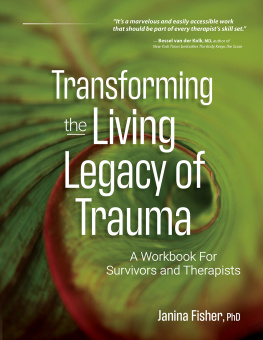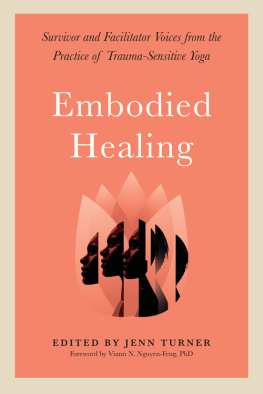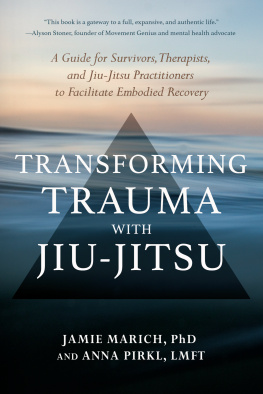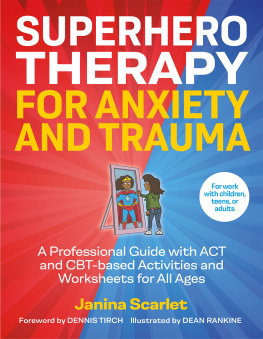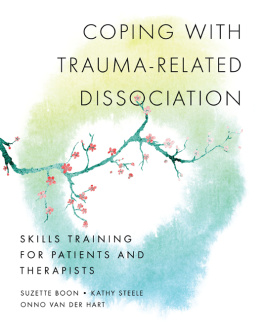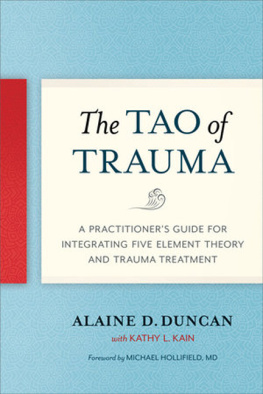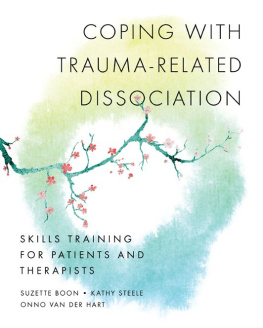Praise for
Transforming The Living Legacy of Trauma
Reading Janina Fishers wonderful, generous, and beautifully written Transforming The Living Legacy of Trauma reminds me of how much we, as a profession, have learned in only three short decades. This book beautifully articulates how mind and body adapt to intolerable feelings of terror, self-loathing, and fear of abandonment with a range of ingenious solutions to create some semblance of safety and control. These adaptations endure over time, and eventually tend to interfere with having satisfying relationships with ones self and others. Janina shows us that healing traumatic wounds consists of learning new habits of observation and self-discovery. The goal of treatment is not so much digging up the past but the repair of the injuries suffered as a result of traumatizing experiences. Its a marvelous and easily accessible work that should be part of every therapists skill set.
Bessel van der Kolk, MD, President, Trauma Research Foundation Professor of psychiatry, Boston University School of Medicine author of New York Times bestseller The Body Keeps the Score
Written with her characteristic hopefulness and clarity, this outstanding workbook showcases Janina Fishers unique gift of getting to the essence of things. Complex theories are transformed into simple, easily understood, useful concepts that teach clients to make sense of their symptoms, to befriend their coping strategies, and to practice effective skills to relieve their suffering. Perhaps even more noteworthy, this remarkable book will inspire the confidence that healing is possible for even the most traumatized survivor.
Pat Ogden, PhD, author of Sensorimotor Psychotherapy: Interventions for Trauma and Attachment and The Pocket Guide to Sensorimotor Psychotherapy
Fisher brings the most important concepts of trauma recovery to lifein both words and diagramswith simultaneous simplicity and sophistication. She has a knack for communicating complex trauma-related ideas and information in an economical and easy-to-understand way. And, as always, she offers her readers hope and invaluable practical guidance.
With its easy-to-understand diagrams, powerful case examples, and crystal-clear explanations of complex concepts, this book belongs on every therapists (and not just trauma therapists) and survivors bookshelf. Fisher reaches out to her readers with compassion and encouragement, offering a unique guide to comprehensive healing.
Fishers diagrams and worksheets are being used all over the world by therapists and survivors. They are a valued part of my personal trauma treatment toolbox. In this book, she effectively couples these materials with user-friendly explanations and case examples, bringing them fully to life for the reader. All I can say is wow!
Deborah Korn, PsyD, The EMDR Institute, author of Every Memory Deserves Respect: EMDR, the Proven Trauma Therapy with the Power to Heal
In this succinct and well-organized volume, Janina Fisher distills the essence of modern trauma theory and the deep wisdom of her decades of clinical experience. The result is a welcome, reader-friendly primer for personal use or to support professional work with trauma survivors.
Gabor Mat, MD, author of In The Realm of Hungry Ghosts: Close Encounters With Addiction
Renowned trauma recovery pioneer, Janina Fisher offers a superb, user friendly, and comprehensive guide to healing for all trauma survivors and for therapists as well. Grounded in expert knowledge of neurobiological, Transforming the Legacy of Trauma walks readers step-by-step through an effective process of deep, lasting change, looking both at childhood injuries and at lifelong adaptations to them. Practical, smart, and wise, this book has the power to change your life.
Terry Real , author of The New Rules of Marriage and founder of the Relational Life Institute
This workbook is an extraordinary gift for therapists and clients alike. With her trademark compassion, Dr. Fisher succeeds in de-pathologizing and simplifying the complexities of the cognitive, somatic, emotional, and behavioral residue of trauma. Clients will be tremendously enlightened as they learn about the brains ability to process, store, and remember trauma, how to identify and navigate triggers and destructive coping strategies, the impact of disorganized attachment and dissociation, and how to distinguish an unsafe past from an empowered present. The visual aids make essential information readily accessible while the worksheets and parts perspective replace self-blame and shame with newfound insight, curiosity, self-compassion, and genuine healing. An absolute must-read for every therapist who wants to be trauma informed, and a life-changing workbook for trauma survivors!
Lisa Ferentz, author of Letting Go of Self-Destructive Behaviors: A Workbook of Hope and Healing
Janina Fisher has contributed meaningfully to trauma recovery in this wonderful workbook. With her up-to-date approaches, practical techniques and worksheets to help guide healing, this book is a must have for resolving deeply-held trauma responses. I highly recommend it.
Nancy J. Napier, LMFT, author of Getting Through the Day, Recreating Your Self, and Sacred Practices for Conscious Living
Janina Fisher and I have long followed parallel paths promoting greater attention to stabilization in trauma therapy. Here she furthers her careful, educational, common sense, and resource-rich approach, filling a much-neglected niche in the trauma self-help literature. Fisher successfully balances illuminating commonalities of post traumatic conditions while encouraging readers to select, portion, and pace individualized healing paths. This book provides an excellent adjunct to any course of trauma therapy or personal self-help.
Babette Rothschild , author of The Body Remembers, Vols. 1 & 2 (2000 & 2017) & 8 Keys to Safe Trauma Recovery (2010)
Janina Fisher, PhD, is the assistant educational director of the Sensorimotor Psychotherapy Institute and a former instructor at Harvard Medical School. An international expert on the treatment of trauma, she is the author of Healing the Fragmented Selves of Trauma Survivors: Overcoming Self-Alienation and is co-author with Pat Ogden of Sensorimotor Psychotherapy: Interventions for Attachment and Trauma . She is known for her work on integrating neuroscience research and newer body-centered interventions into traditional psychotherapy approaches. More information can be found on her website: www.janinafisher.com.
It takes a village to write a book, and I am grateful to all the villagers whose work has made mine possible. First, I want to thank the leaders of the trauma treatment village, Bessel van der Kolk and Judith Herman. Without their inspiration, determination, and unrelenting commitment, we would not have a trauma treatment field or a worldwide community of trauma specialists today. I first was inspired to devote my professional life to trauma when I heard Judith Herman speak in 1989, and I still remember the words that changed the course of my career aspirations. She said, Doesnt it make more sense that people suffer because of real things that have happened to them than that they suffer because of their infantile fantasies or their mental illness? It did make sense that real things had happened to my clientsreal and terrible things.



